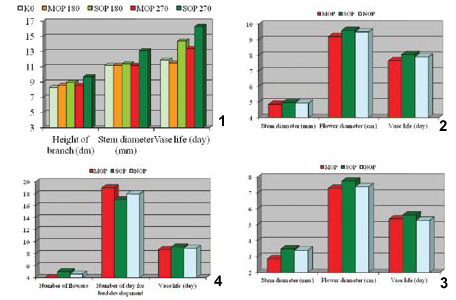Floriculture is an old traditional production with roots in ancient times. Starting from the XVII century, famous authors have written technical books, which show the importance of this special branch of agriculture. During the last century, professionals have developed the production of exotic plants, which needs more and more sophisticated techniques to be produced. Today, cut flowers and pot plants production in the world represents 380,000 ha, of which a large part is produced in greenhouses, and a market of 60 billons euros.
Today Amiran Kenya have partnered with Tessenderlo Group Fertilisers to offer the industry Solucros®, a highly soluble form of potassium sulphate (K2SO4) also known as Sulphate of Potash (SOP) for fertigation systems which is the world most popular and premium quality low chlorine fertiliser. It combines the essential nutrients potassium and sulphur in an optimum form that is readily available to plants to supply a very high concentration of the nutrients.
Speaking on the importance of the product, Mr. Michel Marchand, Tessenderlo Group’s Technical Manager states that when Solucros®, is compared to other potassium sources such as MOP (muriate of potash) and NOP(nitrate of potash), SOP has a very low salinity index making it the preferred potash fertiliser in areas at risk from salinity. He adds to say these features make SOP the most effective fertiliser in many parts of the world as well as the most environmentally friendly.
Solucros®, plays these key roles:
1. Mineral nutrition Mineral nutrition depends on variety and the number of variables linked to cropping conditions. Nevertheless, some common parameters exist such as a pH from 5.5 to 7, a constant supply of water and elements, in an adequate ratio. 1:0.5:1 is usually considered as a basal ratio for a balanced fertilization.
Today, a large part of the cut flower production uses soilless cultivation and fertigation, which explains the popularity of soluble and liquid fertilizers. EC of the solution in the media should not generally exceed 3dS.m-1. Nitrogen is applied in nitrate and ammonium forms, respectively 75% and 25% usually. Potassium is an important element regarding quality and shelf life, sometime required in higher quantity compared to nitrogen. Calcium is essential as part of the cell membrane, playing a role in the rigidity of the stalks.
2. What source of Potassium? Sulphate of Potash (SOP) is more and more used as source of potash in cut flower production as well as for plant in pot. Indeed, potassium nitrate (NOP), which was the main form applied in the past, is more expensive, when potassium chloride (MOP) can be detrimental in a cash crop production and an intensive cropping system, where the risk of chloride accumulation is high. This is well demonstrated in an experiment on marigold, in which SOP and MOP are compared to control at 180 and 270 kg K2O/ha (see graph 1) .
.
Let us look at the producer’s requirement in floriculture: they need a constant production or a production at the same time per plot and the cut flowers should present a homogeneous size, nice colour and a good vase life. Regarding production and quality parameters, SOP shows better results compared to MOP and at least equivalent or better than NOP in recent experiments carried out in India in collaboration with the Horticultural College of Pune University.
Solucros® use in cut flower production Experiments carried out under drip irrigation shows the benefit of Solucros®, compared to NOP and MOP. Flowers fertigated with Solucros® have generally strongest stem, bigger flower diameter and a longer vase life (see graph 2, 3 and 4). New findings in potash fertilization show that potassium sulfate is an alternative to traditional potash sources in flower production, allowing a perfect management of the major element without any risk with chlorine accumulation. The benefit of chlorine free potash fertilizers on production and quality parameters is clearly established. On another hand, the potential of growth for cut flowers and pot plants in the world is important. Thanks to the benefits of potassium and sulphur on quality and production, SOP is becoming the best farmer investment in fertilizer management in floriculture. What are the ideal properties for a soluble SOP? The level of insolubles is critical since these particles can block fertigation systems. In general, a good quality soluble SOP should typically contain less than 0.05% insolubles. A product with more than 0.1% insolubles is generally regarded as bad. Products with more than 0.5% insolubles are often not a soluble grade at all but standard SOP powder.
Maximum solubility is also important as this reflects the concentration of nutrients in the solution. A good soluble grade should have solubility greater than a 12% (the maximum for SOP in pure water is around 13%). The solubility of poor quality grades is normally less than 11%.
Another factor to consider is pH. Generally speaking, acidic products are preferred since they help promote optimal pH around the root zone for maximum nutrient uptake. An acidic solution also tends to protect drippers from clogging. It is also true that acidic products tend to have better solubility than pH neutral materials. Speed of dissolution is of course another important factor for users of soluble SOP.
Solucros® is meeting all these quality criteria and explains is position as a world leader on soluble SOP market and for our Floriculture Industry a perfect product placement in the nutrition regime.
Amiran’s Head of the Agro-Division, Aviv Levi reveals that for plants to grow to their full potential there is need for farmers to invest in products that increase yield and boost growth of the crop. Levi states that as trade between Kenya and European countries expands, the floricultural sector has been challenged to grow more produce and still maintain the high international quality standards. This and more has been part of the reason why Amiran and Tessenderlo Group have come together to make farming a profitable and enjoyable experience for farmers.
